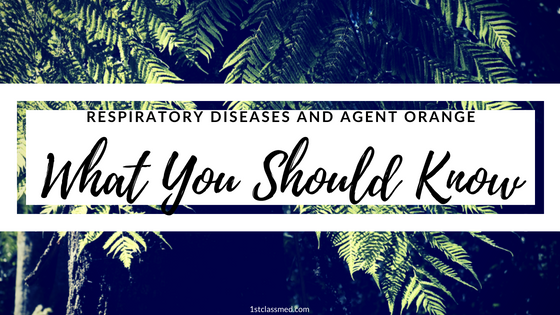
Those who endured the Vietnam War are true heroes, but sadly many of them still suffer from post-traumatic stress disorder (PTSD).
PTSD is not the only thing that Vietnam veterans are suffering with, Agent Orange is also a mark left on their lives.
AO is a harmful herbicide, with a component of it (dioxin) being poisonous to humans.
It was used during the war to kill thick vegetation, making it easier to move throughout the land and make surprise attacks easier.
Agent Orange is known to cause cancer, and other health conditions, but for those with COPD (and many other respiratory diseases) there is still a possible connection.
Agent Orange:
During the Vietnam War, dioxin was used often, killing vegetation and land in the way of the soldiers.
For 9 years, the US military sprayed herbicides (containing dioxin) over the vast forests and thick vegetation of Vietnam.
During the middle of 1961, the president of South Vietnam requested the U.S. conduct aerial herbicide spraying in the country.
In August of 1961, the Republic of Vietnam Air Force, alongside the U.S. proceeded with the spraying.
Over the 9 year time span, roughly 20,000,000 gallons of multiple different herbicides, were sprayed over parts of Vietnam, Laos and Cambodia.

Roughly 12 percent of South Vietnam had been sprayed with herbicides and other chemicals, at a higher concentration that the U.S. Department of Agriculture recommended.
At about 13 times stronger than the government recommended, the chemicals destroyed roughly 10 million hectares.
Each hectare is 100 meters by 10,000 meters squared, and there are about 100 hectares in a square kilometer.
The area destroyed was roughly 100,000 square kilometers or 24,710,538 acres.
That is close to the size of Kentucky at 25,861,773 acres or Indiana at 23,307,347 acres.
Not only did the herbicides affect the land, but also the soldiers and Vietnamese.
Agent Orange enters the body through physical contact, like brushing up against vegetation with the herbicide on it, or by ingestion, like eating a fruit that has the herbicide sprayed on it.
It is also possible to digest from animals such as poultry, eggs, dairy, fish and shellfish, as they can absorb the chemical as well.
It is more common to have exposure through food (like meat, dairy, fish and shellfish) that are contaminated with dioxin.
Dioxin is a chemical that can last years in the environment, in soil, water (lakes and rivers) and in foods.
After contact with AO, the chemical dioxin enters the body and attaches to a protein called aryl hydrocarbon receptor (AhR).
When the chemical binds with AhR, it then moves to the nucleus in a cell and can then influence the gene and change the expression of the gene.
In the 1970’s, high levels of dioxin were found in the blood of U.S. military who had served in Vietnam.
There is also still high levels of dioxin in the soil of multiple former U.S. airbases in Vietnam.
The Department of Veterans Affairs got 39,419 claims from soldiers who believed they were exposed to AO while in Vietnam.
The DVA only compensated 486 of those soldiers, as the soldiers have to prove they got symptoms during their time in Vietnam or within a year of being discharged in order to get any compensation.
Finally, in 1991 the Agent Orange Act allowed the DVA to declare certain conditions “presumptive” to exposure to AO and dioxin.
The last conditions presumed to be from Agent Orange have been added back in August of 2010, but that does not mean there are not more conditions that can possibly be added.
This helped veterans who served in Vietnam have access to treatment and compensation for their condition.
For those whose boots were “not on the ground” (aircrews), were not covered under the Agent Orange Act, and were not eligible for treatment or compensation.
Those who wrote the Act believed that those in the air would not have been affected by the dioxin and herbicides, so there was no reason to cover them under the Act.
A study by the Institute of Medicine, requested by the Veterans Affairs, looked into the risk of aircrews being exposed to AO and dioxin.

In 2015, the Secretary of Veterans Affairs issued an Interim final rule, allowing aircrews, maintenance staff and aero-medical evacuation crews medical care and compensation.
Agent Orange and COPD:
Though Agent Orange is not directly linked to COPD, it is linked to other conditions and many cancers.
The CDC notes that AO causes a higher risk of leukemia, lymphoma, throat cancer, lung cancer, colon cancer, heart disease, soft tissue sarcoma and liver cancer.
Aside from liver cancer, the U.S. Veterans Administration also found that Agent Orange and dioxin can cause all of the conditions above.
Dioxin can cause type 2 diabetes, immune system dysfunction, nerve disorders, muscular dysfunction, hormone disruption and heart disease.
Back in August of 2010, three more conditions were added to the list of illnesses Agent Orange can cause.
Though there have not been any illnesses added in the past few years, it does not mean more will not end up on the list in the future.
For women exposed to dioxin, it is possible for it to cause miscarriages, spina bifida and problems with fetal brain development and nervous system development.
It is also universally known as a carcinogen, which is known to cause cancer.
Many herbicides can cause cancer, but there is not link to other respiratory diseases besides lung cancer and similar cancers.
There is a possibility that the inhalation can trigger lung/respiratory disease, as the dioxin in the herbicides is commonly made from burning gas, oil and coal.
Cigarette smoking can also create dioxins, but the most dangerous dioxin is found in Agent Orange.
Though AO, dioxins and herbicides are not linked to COPD, there are common factors.
Lung cancer can be caused by AO and COPD can increase the risk of lung cancer.

Conclusion:
Overall, those exposed to Agent Orange, dioxins and herbicides are not likely to get COPD or any other respiratory disease besides lung cancer.
Though it is possible that AO, dioxins and herbicides can trigger flare ups in those who already have a respiratory disease.
Those with a respiratory disease should avoid any herbicides and pesticides, as it is possible that fumes and reside can trigger a flare up.
If you feel that Agent Orange may have affected you, speak with your doctor about your concerns and your health to see what may be wrong.



